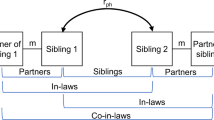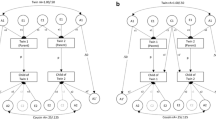Abstract
Using National Longitudinal Survey of Youth (NLSY) fertility variables, we introduce and illustrate a new genetically-informative design. First, we develop a kinship linking algorithm, using the NLSY79 and the NLSY-Children data to link mothers to daughters and aunts to nieces. Then we construct mother–daughter correlations to compare to aunt–niece correlations, an MDAN design, within the context of the quantitative genetic model. The results of our empirical illustration, which uses DF Analysis and generalized estimation equations (GEE) to estimate biometrical parameters from NLSY79 sister–sister pairs and their children in the NLSY-Children dataset, provide both face validity and concurrent validity in support of the efficacy of the design. We describe extensions of the MDAN design. Compared to the typical within-generational design used in most behavior genetic research, the cross-generational feature of this design has certain advantages and interesting features. In particular, we note that the equal environment assumption of the traditional biometrical model shifts in the context of a cross-generational design. These shifts raise questions and provide motivation for future research using the MDAN and other cross-generational designs.
Similar content being viewed by others
References
Bard DE, Rodgers JL (2006) Use of discrete-time survival analysis for modeling multivariate ACE models of fertility precursors from the children of the NLSY. Poster presented at the June, 2006 meetings of the Behavior Genetic Association, Storrs, CN
Baydar N, Greek A (2001) Analysis of data from related individuals. Working paper, Battell Centers for Public Health Research and Evaluation, Seattle WA
Bouchard TJ, Lykken DT, McGue M, Segal NL, Tellegen A (1990) Sources of human psychological differences: the Minnesota Study of Twins Reared Apart. Science 250:223–228. doi:10.1126/science.2218526
Bricker JB, Stallings MC, Corley RP, Wadsworth SJ, Bryan A, Timberlake DS, Hewitt JK, Caspi A, Hofer SM, Rhea SA, DeFries JC (2006) Genetic and environmental influences on age at sexual initiation in the Colorado adoption project. Behav Genet 36:820–832. doi:10.1007/s10519-006-9079-2
Brooks-Gunn J, Warren MP, Rosso J, Gargiulo J (1987) Validity of self-report measures of girls’ pubertal status. Child Dev 58:829–841. doi:10.2307/1130220
Center for Human Resource Research (2006) NLSY79 child & young adult data users guide. Center for Human Resource Research, Columbus
Chase-Lansdale PL, Mott FL, Brooks-Gunn J, Phillips DA (1991) Children of the National Longitudinal Survey of Youth: a unique research opportunity. Dev Psychol 27:918–931. doi:10.1037/0012-1649.27.6.918
Cherny SS, DeFries JC, Fulker DW (1992) Multiple regression of twin data: a model-fitting approach. Behav Genet 22:489–497. doi:10.1007/BF01066617
Damon A, Damon ST, Reed RB, Valadian I (1969) Age at menarche of mothers and daughters with a note on accuracy of recall. Hum Biol 38:255–273
DeFries JC, Fulker DW (1985) Multiple regression analysis of twin data. Behav Genet 15:467–473. doi:10.1007/BF01066239
D’Onofrio BM, Turkheimer EN, Eaves LJ, Corey LA, Berg K, Solaas MH, Emery RE (2003). J Child Psychol Psychiatry Allied Discipl 44:1130–1144. doi:10.1111/1469-7610.00196
D’Onofrio BM, Van Hulle CA, Waldman ID, Rodgers JL, Rathouz PJ, Lahey BB (2007) Causal inferences regarding prenatal alcohol exposure and childhood externalizing problems. Arch Gen Psychiatry 64:1296–1304. doi:10.1001/archpsyc.64.11.1296
Doughty D, Rodgers JL (2000) Behavior genetic modeling of menarche in U.S. females. In: Rodgers JL, Rowe D, Miller WB (eds) Genetic influences on fertility and sexuality. Kluwer Academic Press, Boston
Dunlop DD (1994) Regression for longitudinal data: a bridge from least squares regression. Am Stat 48:299–303. doi:10.2307/2684838
Evans DM, Gillespie NA, Martin NG (2002) Biometrical genetics. Biol Psychol 61:33–51. doi:10.1016/S0301-0511(02)00051-0
Falconer DS (1979) Introduction to quantitative genetics. Longman, New York
Fisher RF (1930) The genetical theory of natural selection. Clarendon Press, Oxford
Fisher RF (1935) The design of experiments. Olyver and Boyd, Edinburgh
Gottesman II, Bertelsen A (1989) Confirming unexpressed genotypes for schizophrenia. Arch Gen Psychiatry 46:867–872
Guo G, Wang JM (2002) The mixed or multilevel models for behavior genetic analysis. Behav Genet 32:37–49. doi:10.1023/A:1014455812027
Harden KP, Turkheimer E, Emery RE, D’Onofrio BM, Slutske WS, Heath AC, Martin NG (2007) Marital conflict and conduct problems in children of twins. Child Dev 78:1–18. doi:10.1111/j.1467-8624.2007.00982.x
Hardin JW, Hilbe JM (2003) Generalized estimating equations. Chapman & Hall/CRC, Boca Raton
Heath AC, Kendler AS, Eaves LJ, Markell D (1985) The resolution of cultural and biological inheritance: Informativeness of different relationships. Behav Genet 15:439–465. doi:10.1007/BF01066238
Huber PJ (1967) The behavior of maximum likelihood estimates under non-standard conditions. In Proceedings of the fifth Berkeley symposium on mathematical statistics and probability, vol 1, pp 221–233
Hughes KA, Burleson MH (2000) Evolutionary causes of genetic variation in fertility and other fitness components. In: Rodgers JL, Rowe DC, Miller WB (eds) Genetic influences on human fertility and sexuality. Kluwer, Boston, pp 7–34
Jinks JL, Fulker DW (1970) A comparison of the biometrical-genetical, MAVA and classical approaches to the analysis of human behavior. Psychol Bull 73:311–349. doi:10.1037/h0029135
Kirk KM, Blomberg SP, Duffy DL, Heath AC, Owens IPF, Martin NG (2000) Natural selection and quantitative genetics of life history traits in western women: a twin study. Evol Int J Org Evol 55:423–435
Kohler H-P, Rodgers JL (1999) DF analysis of binary, ordered, and censored variables using probit and tobit approaches. Behav Genet 29:221–232. doi:10.1023/A:1021686005855
Kohler H-P, Rodgers JL (2001) DF-analysis of heritability with double-entry twin data: Asymptotic standard errors and efficient estimation. Behav Genet 31:179–192. doi:10.1023/A:1010253411274
Kohler H-P, Rodgers JL, Miller WB, Skytthe A, Christensen K (2006) Bio-social determinants of fertility. Int J Androl 29:46–53. doi:10.1111/j.1365-2605.2005.00606.x
LaBuda MC, DeFries JC (1990) Genetic etiology of reading disability: Evidence from a twin study. In: Pavlidis GT (ed) Persepctives on dyslexia, vol 1. Wiley, New York, pp 47–76
Liang K-Y, Zeger SL (1986) Longitudinal data analysis using generalized linear models. Biometrika 73:13–22. doi:10.1093/biomet/73.1.13
Loehlin JC (1989) Partitioning environmental and genetic contributions to behavioral development. Am Psychol 44:1285–1292. doi:10.1037/0003-066X.44.10.1285
Magnus P, Berg K, Bjerkedal T (1985) No significant difference in birth weight for offspring of weight discordant monozygotic female twins. Early Hum Dev 12:55–59. doi:10.1016/0378-3782(85)90137-9
McArdle JJ, Prescott CA (2005) Mixed-effects variance components models for biometrical family analyses. Behav Genet 35:631–652. doi:10.1007/s10519-005-2868-1
McCartan LM (2007) Inevitable, influential, or unnecessary? Exploring the utility of genetic explanation for delinquent behavior. J Crim Just 35:219–233. doi:10.1016/j.jcrimjus.2007.01.008
Mendle J, Turkheimer E, D’Onofrio BM, Lynch SK, Emergy RE, Slutske WS, Martin NG (2006) Family structure and age at menarche: a children-of-twins approach. Dev Psychol 42:533–542. doi:10.1037/0012-1649.42.3.533
Moffitt TE, Caspi A, Belsky J, Silva PA (1992) Childhood experience and the onset of menarche: a test of a sociobiological model. Child Dev 63:47–58. doi:10.2307/1130900
Nance WE, Corey LA (1976) Genetic models for the analysis of data from the families of identical twins. Genetics 83:811–826
Neale MC, Cardon LR (1992) Methodology for genetic studies of twins and families. Kluwer Academic Press, Dordrecht
Plomin R (1990) Nature and nurture: an introduction to human behavior genetics. Brooks/Cole, Pacific Grove
Plomin R, DeFries JC, McClearn GE (1990) Behavior genetics: a primer. Freeman and Company, New York
Purcell S, Koenen KC (2005) Environmental mediation and the twin design. Behav Genet 35:491–498. doi:10.1007/s10519-004-1484-9
Purcell S, Sham PC (2003) A model-fitting implementation of the DeFries–Fulker model for selected twin data. Behav Genet 33:271–278. doi:10.1023/A:1023494408079
Rodgers JL (1996) NLSY Youth linking algorithm. Internal Document
Rodgers JL, Kohler H-P (eds) (2003) The biodemography of human reproduction and fertility. Kluwer Academic Publishers, Boston
Rodgers JL, Kohler H-P (2005) Reformulating and simplifying the DF Analysis model. Behav Genet 35:211–217. doi:10.1007/s10519-004-1020-y
Rodgers JL, McGue M (1994) A simple algebraic demonstration of the validity of DeFries–Fulker analysis in unselected samples with multiple kinship levels. Behav Genet 24:259–263. doi:10.1007/BF01067192
Rodgers JL, Billy JO, Udry JR (1982) The rescission of behaviors: inconsistent responses in adolescent sexuality data. Soc Sci Res 11:280–296. doi:10.1016/0049-089X(82)90012-6
Rodgers JL, Harris D, Vickers KB (1992) Seasonality of onset of adolescent coitus. Soc Biol 39:1–14
Rodgers JL, Rowe DC, Li C (1994a) Beyond nature versus nurture: DF analysis of nonshared influences on problem behaviors. Dev Psychol 30:374–384. doi:10.1037/0012-1649.30.3.374
Rodgers JL, Rowe DC, May K (1994b) DF analysis of NLSY IQ/achievement data: nonshared environmental influences. Intelligence 19:157–177. doi:10.1016/0160-2896(94)90011-6
Rodgers JL, Rowe DC, Buster M (1999) Nature, nurture, and first sexual intercourse in the USA: fitting behavioral genetic models to NLSY kinship data. J Biosocial Sci 31:29–41.
Rodgers JL, Rowe DC, Miller WB (eds) (2000) Genetic influences on human fertility and sexuality: theoretical and empirical contributions from the biological and behavioral sciences. Kluwer Academic Publishers, Boston
Rodgers JL, Hughes K, Kohler H-P, Christensen K, Doughty D, Rowe DC, Miller WB (2001a) Genetic influence helps explain variation in human fertility: evidence from recent behavioral and molecular genetic studies. Curr Dir Psychol Sci 10:184–188. doi:10.1111/1467-8721.00145
Rodgers JL, Buster M, Rowe DC (2001b) Genetic and environmental influences on delinquency: DF analysis of NLSY kinship data. J Quant Criminol 17:145–168. doi:10.1023/A:1011097929954
Rodgers JL, Kohler H-P, Kyvik K, Christensen K (2001c) Behavior genetic modeling of human fertility: findings from a contemporary Danish twin study. Demography 38:29–42. doi:10.1353/dem.2001.0009
Rodgers JL, Johnson A, Bard DE (2005) NLSY-Children/Young Adult (1986–2000) kinship linking algorithm. Internal document
Rodgers JL, Bard DE, Miller WB (2007) Multivariate cholesky models of human female fertility patterns in the NLSY. Behav Genet 37:345–361. doi:10.1007/s10519-006-9137-9
Segal N, McGuire J, Havlena PG (2006) IQ similarity in virtual twins: Developmental trends. Paper presented at the June, 2006, meetings of the Behavior Genetic Association, Storrs, CN
Shadish WR, Cook TD, Campbell DT (2002) Experimental and quasi-experimental designs for generalized causal inference. Houghton-Mifflin, Boston
Siegel DM, Aten MJ, Roughmann KJ (1998) Self-reported honesty among middle and high school students responding to a sexual behavior questionnaire. J Adolesc Health 23:20–28. doi:10.1016/S1054-139X(97)00274-7
Silberg JL, Eaves LJ (2004) Analyzing the contribution of genes and parent-child interaction to childhood behavioral and emotional problems: a model for the children of twins. Psychol Med 34:347–356. doi:10.1017/S0033291703008948
Truett KR, Eaves LJ, Waiters EE, Heath AC, Hewitt JK, Meyer JM, Silberg J, Neale MC, Martin NG, Kendler KS (1994) A model system for analysis of family resemblance in extended kinships of twins. Behav Genet 24:35–49. doi:10.1007/BF01067927
Trumbetta SL, Markowitz EM, Gottesman II (2007) Marriage and genetic variation across the lifespan: not a steady relationship? Behav Genet 37:362–375. doi:10.1007/s10519-006-9132-1
Udry JR (1996) Biosocial models of low-fertility societies. In: Casterline JB, Lee RD, Foote KA (eds) Fertility in the United States: new patterns, new theories. The Population Council, New York
Upchurch DM, Lillard LA, Aneshensel CS, Li NF (2002) Inconsistencies in reporting the occurrence and timing of first intercourse among adolescents. J Sex Res 39:197–206
van den Oord EJCG (2001) Estimating effects of latent and measured genotypes in multilevel models. Stat Methods Med Res 10:393–407. doi:10.1191/096228001682157625
van den Oord EJCG, Rowe DC (1997) Continuity and change in children’s social maladjustment: A developmental behavior genetic study. Dev Psychol 33:319–332. doi:10.1037/0012-1649.33.2.319
van den Oord EJCG, Rowe DC (2000) Racial differences in birth health risk: a quantitative genetic approach. Demography 37:285–298. doi:10.2307/2648042
Van Hulle CA, Rodgers JL, D’Onofrio BM, Waldman ID, Lahey BB (2007) Sex differences in the causes of self-reported adolescent delinquency. J Abnorm Psychol 116:236–248. doi:10.1037/0021-843X.116.2.236
Waller NB (1994) A DeFries and Fulker regression model for genetic nonadditivity. Behav Genet 24:149–153. doi:10.1007/BF01067818
White H (1980) A heteroskedasticity-consistent covariance matrix estimator and a direct test for heteroskedasticity. Econometrica 48:817–838. doi:10.2307/1912934
Author information
Authors and Affiliations
Corresponding author
Additional information
Edited by Danielle Dick.
Appendix A: SAS Coding to estimate the DF Analysis model using GEE procedures to obtain sandwich standard errors
Appendix A: SAS Coding to estimate the DF Analysis model using GEE procedures to obtain sandwich standard errors


Rights and permissions
About this article
Cite this article
Rodgers, J.L., Bard, D.E., Johnson, A. et al. The Cross-Generational Mother–Daughter–Aunt–Niece Design: Establishing Validity of the MDAN Design with NLSY Fertility Variables. Behav Genet 38, 567–578 (2008). https://doi.org/10.1007/s10519-008-9225-0
Received:
Accepted:
Published:
Issue Date:
DOI: https://doi.org/10.1007/s10519-008-9225-0




